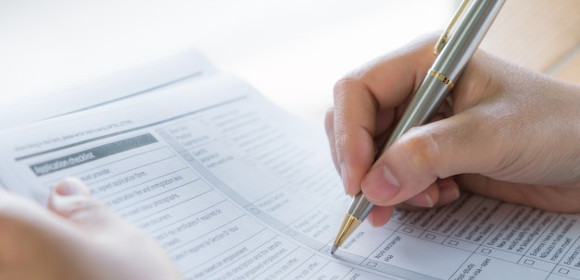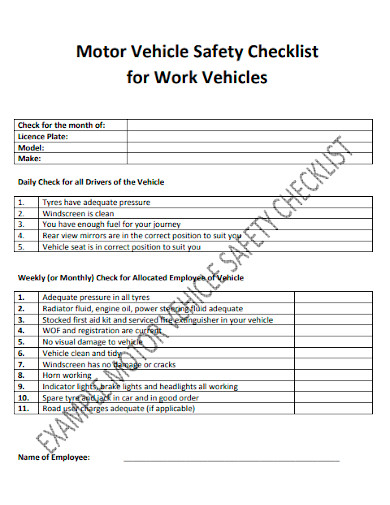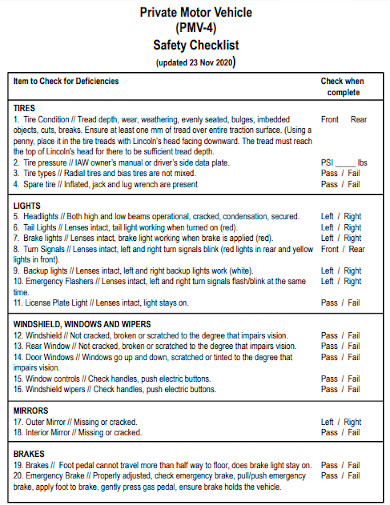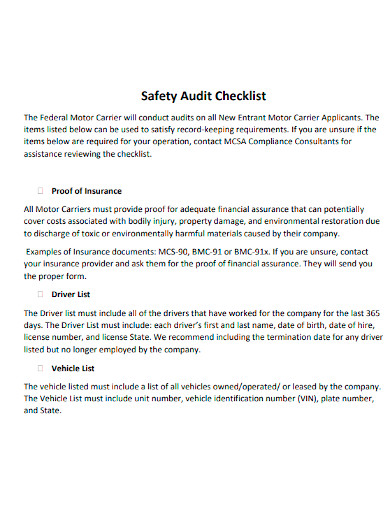According to statistics, a significant portion of US death toll per year is caused by car crashes. With a fatality rate of 12.4deaths per a hundred thousand household. A common cause for these fatal accidents are speeding, substance abuse, distractions along the road, and many others. But there is one factor that, even though it is not as common, it could still lead to accidents on the road, and I feel like it most often quite overlooked. That is the failure to maintain and exercise motor vehicle maintenance procedures. When a car is poorly maintained, it exposes the driver to a high chance of bigger problems surfacing down the line, and when worst comes to worst, a deadly accident.
Owning a motor vehicle is more than just driving it properly along the highway. One of the biggest parts in owning a car is to keep it in tiptop shape. Keeping it well, fully, and properly maintained. A well maintained vehicle ensures that maintenance repairs are kept at a minimum, and helps avoid the risk of having a vehicle that’s gonna end up leaving you stranded in the middle of the highway. Of course, we don’t expect everyone to have complete knowledge of everything that has to do with their vehicles. Most of the time, car owners would just prefer to leave their car to their local mechanics and let them handle the difficult stuff. But being able to know how to keep your own vehicle safe and maintained is a valuable skill to have, especially for car owners. It’s always good to be able to conduct preliminary safety procedures periodically and even right before a long trip. It’s a good responsible practice and the benefits last the long run. Now, of course, to make sure that your safety inspection covers everything and is actually effective. It’s a good idea to establish a vehicle safety checklist beforehand. Check out these motor vehicle safety checklist samples to get to know the document better, be familiar with the components inside it, and know what a well written checklist looks like.
4+ Motor Vehicle Safety Checklist Samples
1. Motor Vehicle Safety Checklist Sample
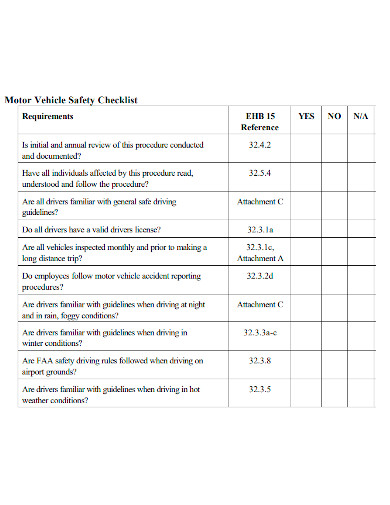
2. Printable Motor Vehicle Weekly Safety Checklist
3. Standard Motor Vehicle Safety Checklist
4. Private Motor Vehicle Safety Checklist
5. Motor Vehicle Safety Audit Checklist
What Is a Motor Vehicle Safety Checklist?
Vehicle safety checklists are, checklists. This document essentially enables you to inspect and assess the condition of your vehicle on your own. You can do the safety inspection right before a trip or even a periodical safety inspection. A vehicle safety checklist lets you do this by giving you an overview of certain car parts or components and provides a description of what their optimal status should be. If a component does not meet the description provided by the checklist, then there might be a problem causing it. The checklist should also be able to help you with the small repairs by giving you an outline of how to do basic troubleshooting. Professional mechanics also use checklists such as these to have a guideline to work with when doing safety inspections. Basically about the same thing. Only difference is, checklists by professional mechanics tend to be much more detailed and deals with more specialized tasks.
How to Create a Motor Vehicle Safety Checklist
Creating your own checklist usually means that you are perfectly knowledgeable about cars in general. You know every part of a vehicle and how it should work. If that’s not the case, then don’t worry, we suggest you use the samples and templates we have provided above. Otherwise, stick around, we’ll give you a rundown of the components that should be found on a safety checklist, and a couple tips in writing it as well.
- Contact information
You should always remember to include the information of both the owner of the vehicle and the person in charge of the safety inspection. If you are both, then you should reflect that on your checklist. Information such as name, contact numbers, email, and their signature. - Identification
Reflect any sort of identification of both the owner or the vehicle and the person doing the safety check. Driver’s license, valid ID, registration, etc. - Specify the vehicle’s details
There are countless of motor vehicle types, models, and units in the world. And each of those has specific components that make them different from one another, except if it is the same kind of course. So you should specify those details to make the safety check easier and if there are any replacements to be made, compatible. - Main inspection
This will be the main part of the checklist because this will be the checklist itself. Here are the most basic components that your safety checklist should cover.- Engine oil check
- Battery check
- Headlights and turn signals check
- Tire treads check
- Windshield wipers check
- Belts in and around the hood of the car
- Make sure that the auto emission sticker is up to date
- Brake and rearview lights check
- Brake test
And that should cover just about everything of the basics. It is important to note that the more specific components entirely depend on the build, model, and type of the vehicle that you will be inspecting. So make sure to keep that in mind.
FAQs
Why is a vehicle inspection important?
The most obvious reason to always safety check your vehicle is for safety purposes.
What is a daily routine check?
A daily routine check is a process that checks the condition of your car on a daily basis. It should inspect vehicle fluid levels such as engine oils, brake, clutch, steering, and transmission.
What is a vehicle checklist?
A vehicle inspection checklist is used to assess and evaluate a vehicle’s condition. It should help identify various mechanical issues or defects that a vehicle currently has.
Owning your own vehicle is a massive responsibility in of itself. Making sure that your vehicle is constantly in a good condition does not only make you safe, but the people around you as well. Periodical maintenance should also keep you from spending too much money on much bigger repairs.
Related Posts
FREE 11+ Sample Maintenance Request Forms
FREE 11+Incident Investigation Form Samples
FREE 11+ External Audit Report Samples & Templates
FREE 10+ Vehicle Service Contract Samples
FREE 10+ Car Accident Police Report Samples
FREE 10+ Sample DMV Release Forms
FREE 8+ Car Rental Agreement Samples
FREE 7+ Equipment Checklist Samples
FREE 7+ Sample Vehicle Bill of Sale Templates
FREE 37+ Checklist Samples
FREE 35+ Risk Assessment Form Samples
FREE 12+ Audit Checklist Samples
FREE 12+ Vehicle Purchase Agreement Samples
FREE 10+ Statement of Facts Samples
FREE 9+ Sample Insurance Release Forms
